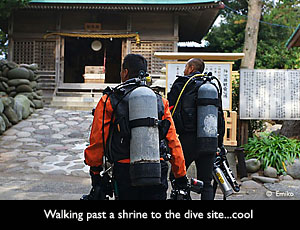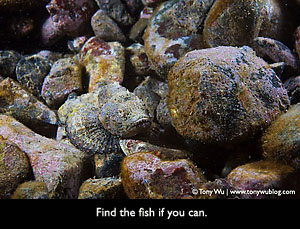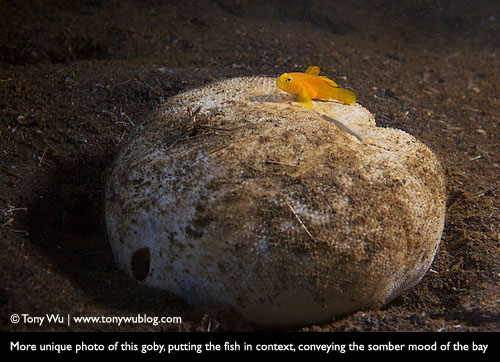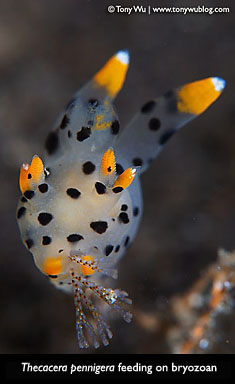 On the western side Izu, near the very top of the peninsula, is a place called Osezaki, basically a small protected bay where divers from Tokyo and surrounding areas go to get certified, and dive when the winds and waves in other parts of Izu act up.
On the western side Izu, near the very top of the peninsula, is a place called Osezaki, basically a small protected bay where divers from Tokyo and surrounding areas go to get certified, and dive when the winds and waves in other parts of Izu act up.
The bay is shallow, starting with a pebbly/ rocky bottom at the shoreline, extending to a pile of big rocks and boulders a short swim out, then dropping into mud and muck from about seven metres depth onward. Reflecting the volcanic nature of the Japanese archipelago, the bottom is dark. The pebbles, rocks and boulders are stone grey, and the muck looks like...muck.
There's usually very little current, so diving conditions are normally not the least bit challenging (except perhaps for the low water temperature), but it's really easy to stir up the bottom, so when it's crowded (as in Japanese-style crowded, with 2,000+ divers), visibility drops to virtually zero.
I recently visited Osezaki again (after having done a few dives in Osezaki on my initial dive foray in Japan last year). With writing and photo assignments piling up, plus meetings waiting for me back in Tokyo, I unfortunately only had time to do four dives.
Concentrating on Creativity
 A while back, after I visited the Lembeh Strait, another renowned muck location, I wrote about the importance of being creative with underwater photography. On that trip, which was much longer than the time I had for this trip to Osezaki, I spent much of my time experimenting with lights and lens perspectives to try to get unique shots from a location that just about every well-travelled underwater photographer in the world has visited. In other words, I didn't want to take the same photos of the same animals in the same way as everyone else.
A while back, after I visited the Lembeh Strait, another renowned muck location, I wrote about the importance of being creative with underwater photography. On that trip, which was much longer than the time I had for this trip to Osezaki, I spent much of my time experimenting with lights and lens perspectives to try to get unique shots from a location that just about every well-travelled underwater photographer in the world has visited. In other words, I didn't want to take the same photos of the same animals in the same way as everyone else.
My thoughts from Lembeh seemed even more relevant here, because just about every diver in Japan (at least those who live in and around Tokyo) has visited Osezaki, and taken nearly identical photos of the same animals...over and over and over again.
Part of the reason for this is that the dive guides are really good, and they work well together to share information to make sure that visitors see the most interesting critters around...in other words, everyone tends to see the same things.
Another reason is that domestic divers are usually in a rush. For example, they drive down at 5am on Saturday morning, do 2-3 dives, and then drive back to Tokyo, or perhaps stay one night, do 2-3 more dives, then head back to Tokyo on Sunday. Like busy city people everywhere, divers who visit like this rarely have enough time to switch from the "rush-rush" office mentality to an "observe-and-enjoy" demeanor that fosters creativity.
With only four dives scheduled, I didn't have a lot of time to experiment, but as Louis Pasteur wisely noted in a lecture in 1854:
Dans les champs de l'observation le hasard ne favorise que les esprits préparés
...which roughly translates to "Fortune favours the prepared mind."
Uncommon Photo of a Common Fish
 Lubricogobius exiguus is a common goby in these parts, and there were lots of them around. Because of their bright yellow colouration and sparkling emerald-green eyes, they're incredibly photogenic, especially given the overall dark mucky mood in Osezaki.
Lubricogobius exiguus is a common goby in these parts, and there were lots of them around. Because of their bright yellow colouration and sparkling emerald-green eyes, they're incredibly photogenic, especially given the overall dark mucky mood in Osezaki.
Usually found in pairs, these bright yellow fish often live in discarded bottles, cans and other rubbish. Once discovered, they're easy to spot again and again, which means that dive guides show them to everyone, and everyone consequently gets very similar photos of them...i.e., fish faces peeking out of a can or bottle.
I'm not trying to dish photos like this, because they're usually quite good and the fish are admittedly adorable, but after seeing a few hundred similar, if not identical, shots, it's tough to get much of a rise.
In the course of one of our pre-dive discussions, Aihara-san, my dive guide, told me about several pairs of these brilliant yellow fish. My lack of enthusiasm apparent, Yoko-san, another guide, showed me a snapshot she took an earlier dive with a pair of L. exiguus living in a sea biscuit (the skeletal remains of a sea urchin).

Ding! My mental light bulb went off, and I realised I had an excellent opportunity to stretch my creative limits. Soon, with location, depth and behaviour description in hand, I set up my camera and lights, explained the photo concept I had in mind to Aihara-san, and off we went to try to create art.
Back on shore an hour later, I had exactly what I wanted...a unique photograph of a very common animal that conveys the somber, often lonely, mood of its natural habitat.
Practical Information
 If you find yourself in Japan and want to give Osezaki a try, the secret to diving Osezaki is to avoid weekends and holidays, i.e., the times when crowds of people schlep down from Tokyo (3 hours or so away by car) for open-water certification dives. If you hit Osezaki on a weekday, there'll only be a few people diving, most of whom should be fairly experienced divers.
If you find yourself in Japan and want to give Osezaki a try, the secret to diving Osezaki is to avoid weekends and holidays, i.e., the times when crowds of people schlep down from Tokyo (3 hours or so away by car) for open-water certification dives. If you hit Osezaki on a weekday, there'll only be a few people diving, most of whom should be fairly experienced divers.
Also, the water temperature is chilly, ranging from around 20ºC last week down to a brisk 12ºC or so in February/ March. I used a drysuit, as most other people were doing. A few braved the water with double 6.5mm wetsuits. Summer is a bit warmer, but it's crowded, as non-divers visit to hang out on the beach too.
If you've got Japanese friends, a quick Google search will turn up dive shop names in Osezaki (大瀬崎). There are about 10 or so from what I can tell. There are basic accommodations too, though it might be worth staying someplace nearby with better accommodations and driving to the bay in the morning.
If you don't have Japanese friends, it's still possible to dive in Osezaki, but it's not easy. As a rule, there's very little English spoken, and there's no public transport, which means you'll need to navigate your way there by car, or arrange for a pick-up from a nearby train station. There is some information available in English if you Google Osezaki.
The shop I dived with both last year and this is called Hamayuu. It's not the biggest in Osezaki, but the guides are knowledgeable and very friendly.
 Finally, it's worth noting that Osezaki lies off Suruga Bay, which is very, very deep. All sorts of weird critters end up here. I met Hideki Abe during my trip, who's renowned for his photographs of cephalapods. He recently photographed a baby giant squid (Architeuthis dux) in the bay. How's that for awesome?
Finally, it's worth noting that Osezaki lies off Suruga Bay, which is very, very deep. All sorts of weird critters end up here. I met Hideki Abe during my trip, who's renowned for his photographs of cephalapods. He recently photographed a baby giant squid (Architeuthis dux) in the bay. How's that for awesome?
Also, the waters are seasonal, so the marine fauna change through the year, which means you'll see different things at different times of the year. Little known outside Japan, Osezaki is an incredible muck-dive location that I hope to visit again soon.